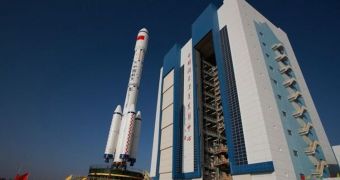The China National Space Administration (CNSA) is ready to launch its Tiangong 1 space module, the first of two spacecraft meant to demonstrate that the Asian nation is capable of constructing a space station. Launch is scheduled to occur today, September 29, between 1316 and 1331 GMT.
In itself, Tiangong 1 is in fact one of the modules that will form the basis of the new space station. Its goal is to conduct an orbital docking maneuver with a Shenzhou-8 spacecraft, which will be launched later this year or in early 2012.
When both are in space, they will attempt to join hatches, essentially creating the backbone for a new space station. As Tiangong 1 waits for Shenzhou-8 to arrive at the rendezvous point, its instruments will be conducting a series of scientific tests in microgravity.
Space reports that the Long March 2FT1 delivery system which will launch the new capsule is already fueled, and ready to take off during the designated window of opportunity. That spacecraft will take off from the Jiuquan Satellite Launch Center, in northwestern China.
If the rendezvous maneuver is successful, then CNSA will conduct a number of such docking procedures over the next two years, in an attempt to refine its orbital capabilities. After this phase of the plan is conducted, the country will begin working towards building its space station.
The project is currently scheduled to end no later than 2020, the official Xinhua news agency reports. The 8.5-ton Tiangong 1 should therefore be thought of as holding the key to China's presence in space.
Even if the mission fails during launch, or in orbit, the setback is not likely to make a difference for CNSA in the long run. The agency will simply construct a new capsule, and sent it to replace Tiangong 1 as soon as possible.
Initially, the new mission was supposed to launch earlier in the week, but meteorologists announced that a cold weather front was heading towards the launch pad. As such, the take-off sequence was aborted, and the launch delayed for a few days
“The main tasks of [the] Tiangong 1 spaceflight include: to provide a target vehicle for space rendezvous and docking experiment; to primarily establish a manned space test platform capable of long-term unmanned operation in space with temporary human attendance,” Wu Ping says.
The capsule will also have to “accumulate experiences for the development of the space station; to carry out space science experiments, space medical experiments and space technology experiments,” the Manned Space Engineering office spokeswoman said.

 14 DAY TRIAL //
14 DAY TRIAL //